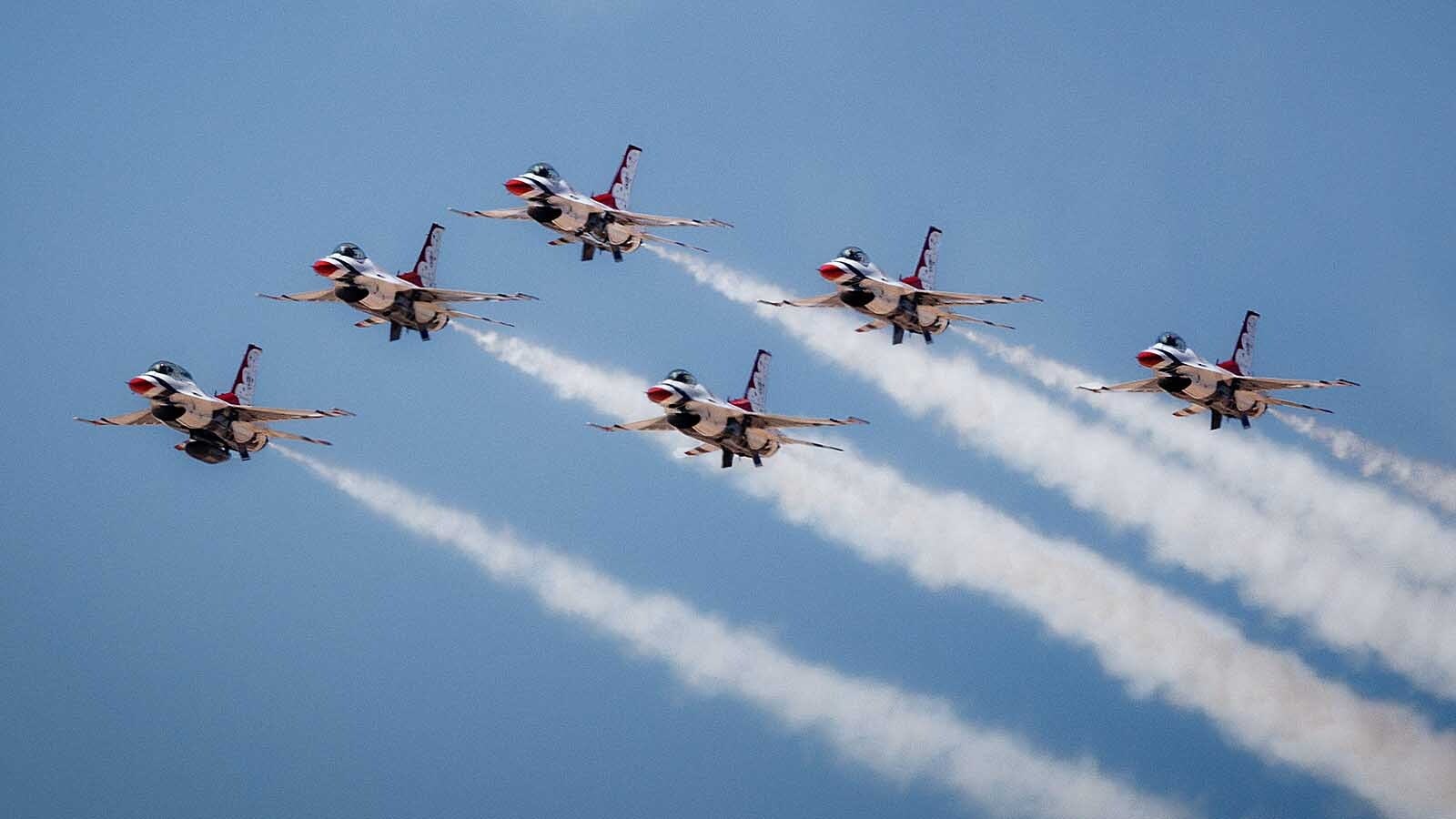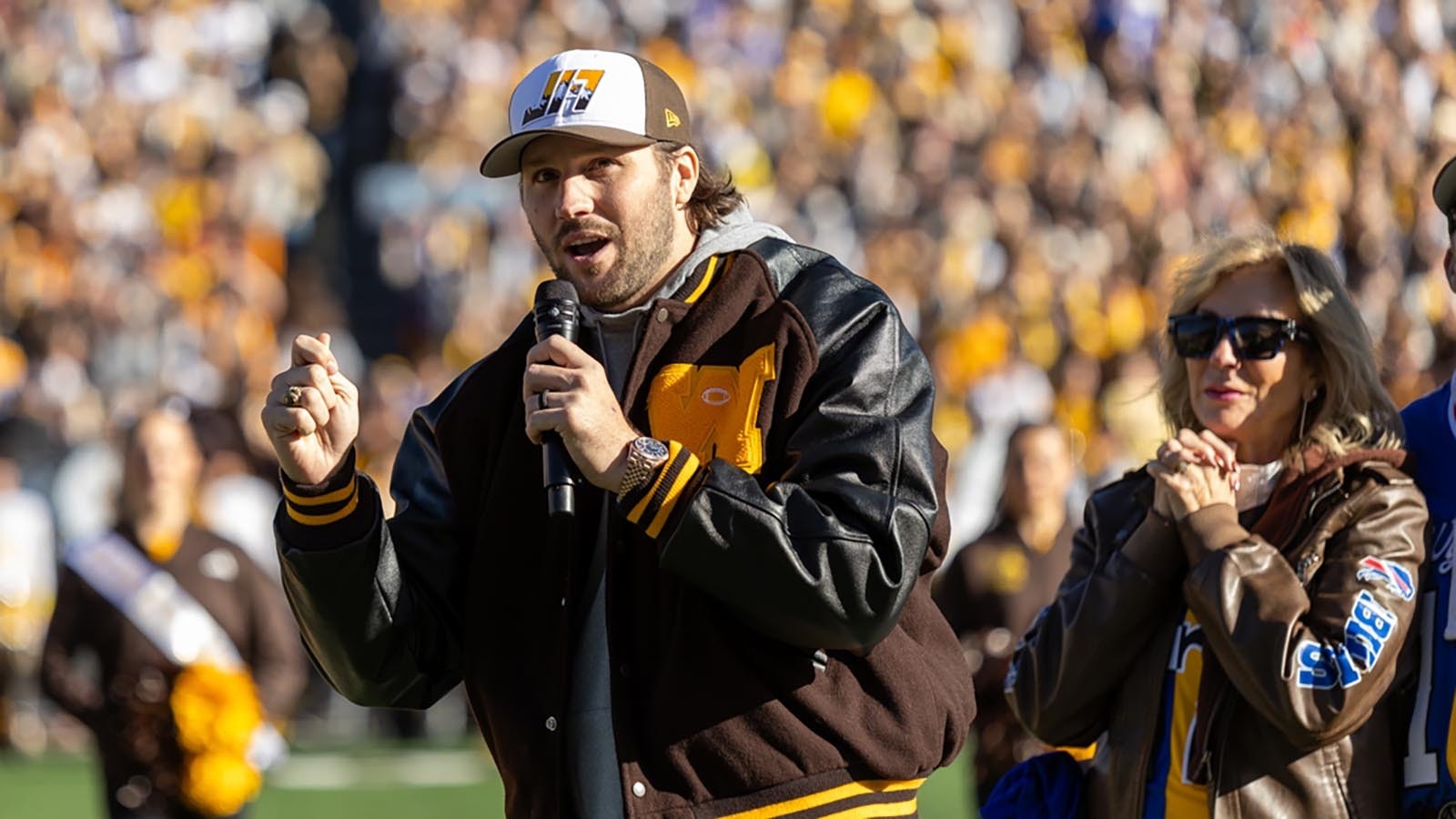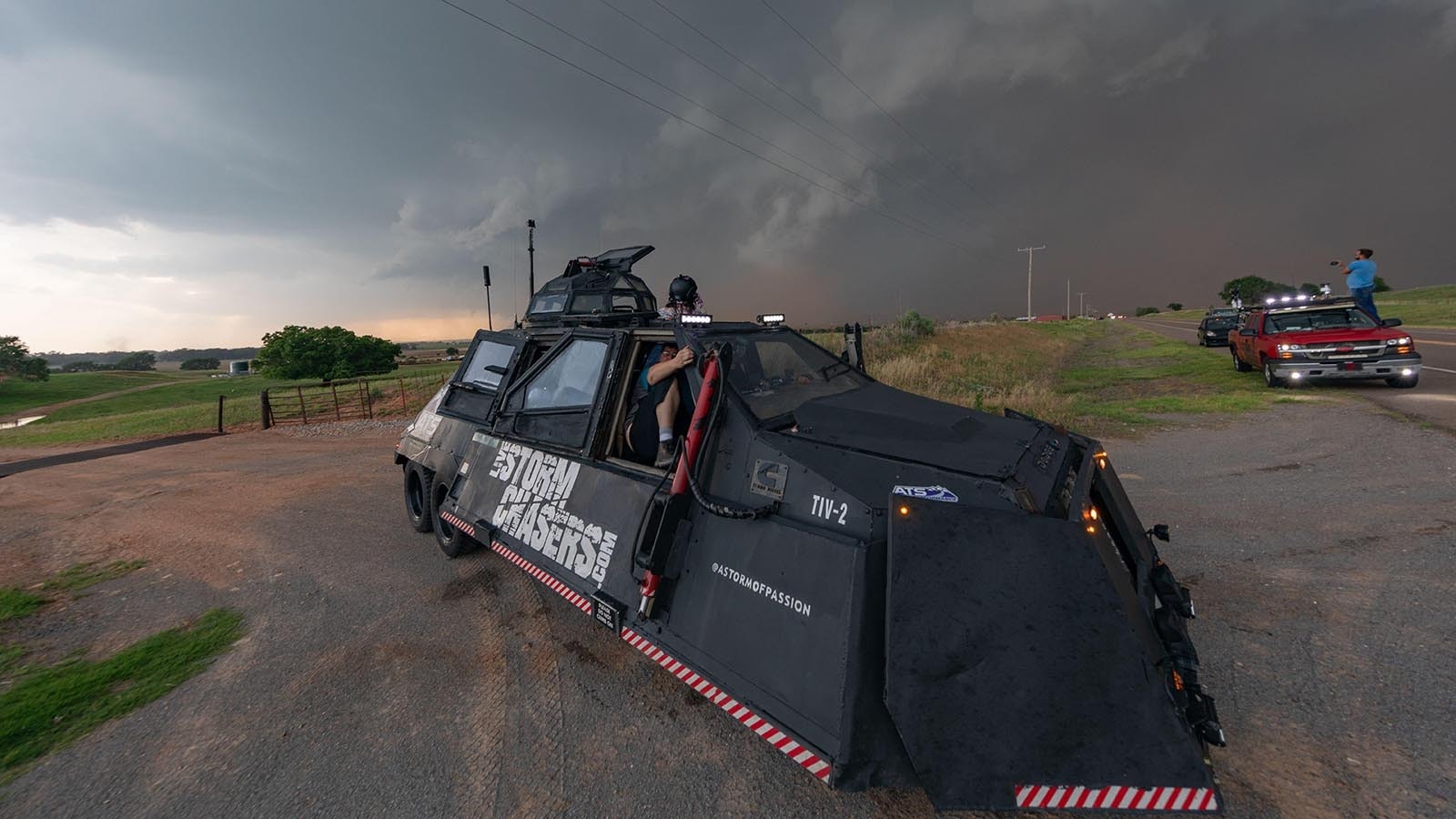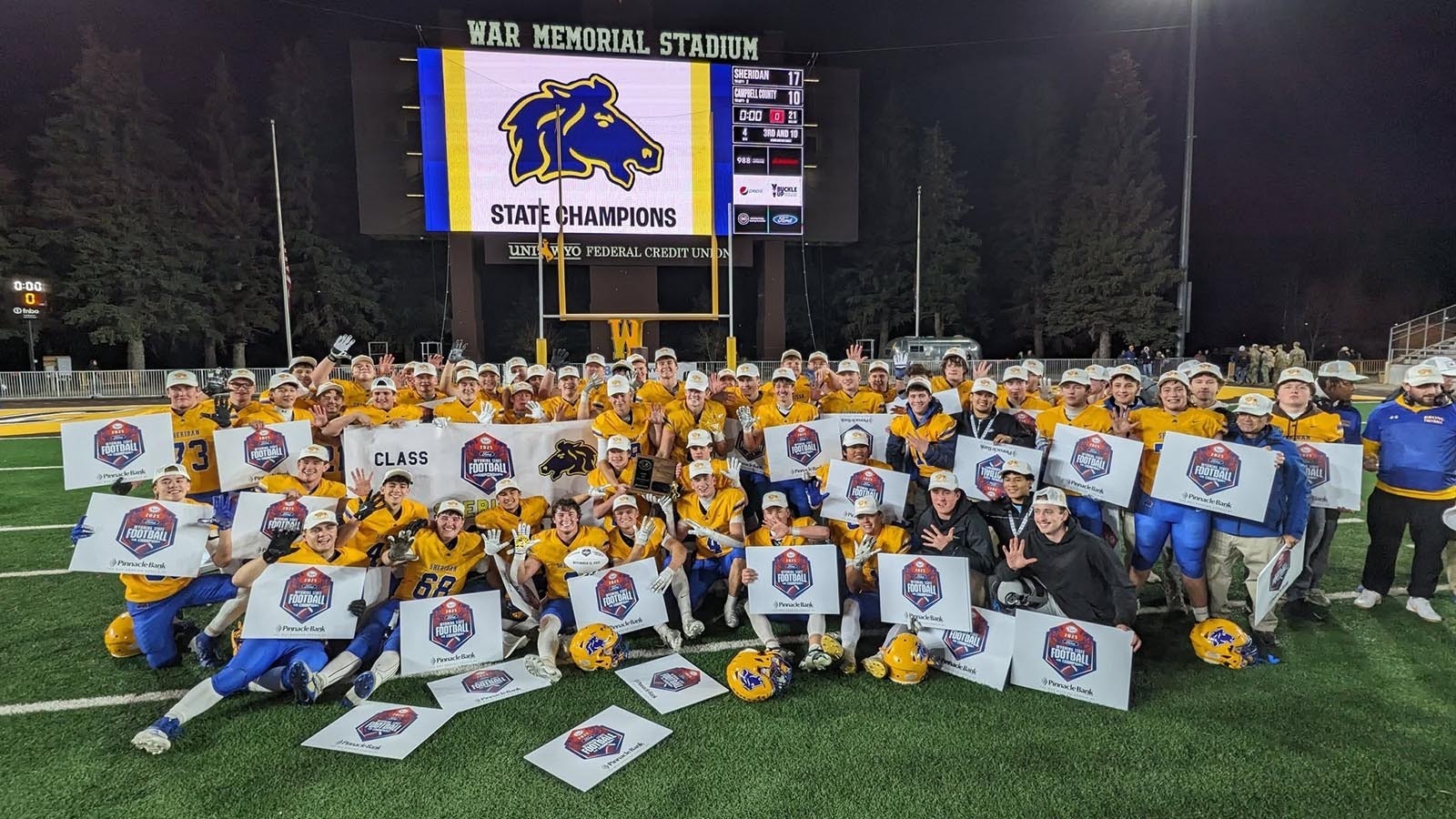CHEYENNE — From a distance, all the Thunderbird F-16 Fighting Falcon planes look the same, but there is one that has a telling difference from all the others.
That plane has the number “5” on it upside down.
The plane’s pilot is Maj. Jeffrey Downie, call sign “Simmer.”
Ask him what’s behind that nickname, and he’ll say the price is a beer. Offer to pay that price, though, and he’ll laugh and inform you he doesn’t actually drink beer. Some things in life just have to remain inscrutable to the outside world.
And the Thunderbirds, and many of their inside pilot jokes, are among them.
There is one inside joke Downie will explain without a beer. That’s the upside-down number on his plane.
“So, it started as a joke about 36 years ago,” he told Cowboy State Daily, standing plane side just after landing in Cheyenne for another Wings Over Wyoming Airshow. “One of the crew chiefs turned the five upside down, because the lead solo — which is my position — flies most of the air show maneuvers upside down.
“That joke has stuck ever since. So, I get to represent all my brochures on the jet, my uniform and my autograph, I always put the five upside down.”
It’s a little bit like the old rodeo joke, where the cowboy says after his 8-second ride that he thought he must have gotten on his bull backwards, because he never saw its head during the ride.
Downie laughs a little at that, but then he turns serious, because flying with the Thunderbirds is no joke.
“I’ve never ridden a bull, and I have no desire to,” Downie said. “But it can get a little bit bumpy in there.”
It is not just a bumpy ride. It’s death-defying, with planes 18 inches apart flying at speeds that exceed 500 mph. And the ride lasts a lot longer than eight seconds.
It’s a ride the Thunderbirds have been making over Cheyenne for decades. The team’s connection with Wyoming goes back 72 years, when the 1953 Cheyenne Frontier Days was the first civilian air show for the Thunderbirds. They’ve been back almost every year since, except for two.
They Love The Challenge
Ask Downie if he’s one of the best pilots in the world, and he will demur.
“You have to be above average for sure on the flying side of the house,” he said. “But you don’t have to be God’s gift to aviation. We really look for people who are going to represent the team and the brand, people who are humble and approachable. That’s really what we’re looking for.”
But in the Netflix documentary “Air Force Elite: Thunderbirds,” which was released in May and which Downie helped to narrate, his voice is unequivocal about the status of the pilots who fly these highly maneuverable, multi-function planes called Thunderbirds.
They are the best pilots in the world, and they knowingly fly on the edges of humanity’s capabilities. Their goal is shock and awe — inspiration that can help pull a nation together.
Twenty-one Thunderbird pilots have been killed in the team’s 70-plus-year history, most during training exercises. Three of them have beenduring air shows.
“We get to a point where you’re kind of at the limit of human ability to absorb movement,” Downie said. “And you know, a lot of times it depends on the environmental turbulence we’re getting off buildings and terrain.
“Blacktop parking lots with huge columns of hot air. They kind of affect the ability of the jets and how smooth the air is. So, any given day can be different, and always a challenge.”
The Thunderbirds have three types of air shows they can fly: high, low and flat.
“It depends on the height of the clouds,” Downie said. “And then there’s certain, obviously, visibility requirements to be able to see the other aircraft as we’re pointing our noses at each other and passing at the very last second.”
Weather has an enormous impact on what the show can do and, at times, has meant the show actually can’t go on.
“High density altitude is a thing, especially here at the show at Cheyenne and F.E. Warren,” Downie said. “The aircraft bleeds energy a lot faster and it makes it very difficult for us.”
He thinks for a moment as he says that, then adds, “But we always love a good challenge.”
Feel The Power Of The Jets In Your Body
Saturday’s Wings Over Warren Airshow from 11 a.m. to noon will feature six planes flying inches apart with what Downie described as a “plethora” of death-defying maneuvers for a 37-minute audience thrill ride.
Traditionally, the event has been held midweek, but the performance was moved to Saturday in hopes of engaging with more people during their visit to Cheyenne Frontier Days.
The free public event is held directly adjacent to Frontier Park, and will include food trucks, inflatable games and static displays of Black Hawkand Huey helicopters.
“This is an incredible performance,” Downie said. “It’s not just watching jets. You’re part of the action. You feel the power of these jets through your body.”
Four of the planes will be part of what’s called the diamond formation, while the other two are flying solo maneuvers during the show.
The point of having these two types of maneuvers is to showcase different things. The solo flights highlight the extreme capabilities of the F-16 Fighting Falcon in terms of speed, maneuverability and performance limits. The diamond formation showcases the team’s precision and training.
While pilots cycle in and out of the Thunderbirds team on a regular basis, they never switch the type of plane they fly.
If they start as diamond formation pilots, they stay diamond formation pilots. If they start as solo pilots, they will remain solo throughout their Thunderbirds tenure.
“You can’t just plug and play around,” Downie said. “That’s because it’s so different and so highly specialized. There are no backup pilots for this. We’re the only people in the world who can fly our position for this demonstration.”

How They Bring The Jets Together
The diamond is the tightest flying formation that exists.
At just 18 inches apart at speeds exceeding 500 mph, this formation takes nerves of steel to accomplish. It also takes something else, completely counterintuitive — blind trust.
Each of the pilots must fly their plane trusting that their fellow pilots have nailed their positions to within an inch.
Anything less than that precision, and the whole diamond formation can crash and burn, killing all four pilots.
The key to this formation is training. They’ll start out at typical fighter formation distances, 5 to 6 feet, and then draw it in closer and closer until they are just 18 inches apart.
It’s remarkable, given that 5 to 6 feet is already considered a difficult challenge.
“It’s very precise flying,” Downie said. “It’s very small pressures on the stick and the controls. It takes a lot of attention to detail, a lot of precision to fly even (5 to 6 feet apart). And then we take it to the next level, bringing things tighter and tighter and tighter.”
The lead pilot is aiming his plane straight at the ground during part of the diamond formation routines. It will crash if the companion plane doesn’t slide into the exact right spot, giving the lead plane the additional lift it needs to stay at exactly 100 feet above the ground.
The slightest bobble of any one plane’s controls with human hands at this point can cause a four-jet collision, so the blind trust these maneuvers require is not easily given.
It is earned through days and days of nonstop practice together as a team, not just learning their capabilities, but expanding them.
“Our training season starts the day after our very last show in November,” Downie said. “We’ll fly twice a day, every day, for six days a week, and sometimes seven days a week, all the way up through March. We’ve got those five months to really hone our craft, and just repetition, repetition, repetition, day after day.”
Dealing With Maximum G-Forces
The diamond ship’s signature maneuver is called the high bomb burst. It is a difficult and dangerous maneuver, one that skirts the edges of the g-force that humans can withstand.
G-force, or gravitational force, measures the effect of acceleration force on a stationary body, like a pilot in an airplane. One “G” is equivalent to the normal gravity that’s caused by earth’s own acceleration, at 9.8 meters per second squared.
A force of 4 Gs would be four times that of gravity. That’s the resting tolerance for most people.
A force of 8 Gs would be eight times gravity. At that point, a person weighing 200 pounds is more like 2,000 pounds — almost a ton.
Above 8 Gs, blood starts to drain from the skull, causing unconsciousness very quickly if it continues.
“We pull a lot of Gs throughout the demonstration, as we’re turning and repositioning for the show,” Downie said. “Our target is about 7.5, and we try not to go over that. But if we need it, it’s a 9 G-capable jet, and so we’ll routinely peak out at 8.5 Gs, which is an immense amount of pressure on your body.”
During the high-bomb maneuver, the four-ship diamond will pull straight up into a vertical and then split off in four directions, drawing the petals of a white flower in the sky.
A solo, meanwhile, will climb 3 miles straight up while rolling, while the diamond formation planes continue 3 miles in opposite directions before turning downward and back toward the show’s center.
They close on each other at speeds approaching 1,000 mph while just a few hundred feet off the ground. Getting there means being close to the maximum G-force that each pilot can withstand.

You Hear Them Coming
You’ll hear the Thunderbirds long before you see them. It is the sound of raw power coming down to earth, cracking open the sky.
The sound starts as a low buzz and builds, with white smoke pouring from these cracked seams of sound.
It’s only a fraction of the power available to these planes.
“I’ve done Mach 1.4,” Downie said. “That’s the fastest I’ve gone. Obviously, we can’t do that during an air show or go supersonic, because we would break a lot of windows. But that’s the fastest I’ve gone outside of that.”
It’s not often there’s tactical advantage in that kind of speed, Downie added, and it’s risking more of those g-forces that can cause unconsciousness.
For the pilots who fly with the Thunderbirds, it’s always about testing limits, as safely as possible, and performing at the highest possible capability.
Downie counts his time with the Thunderbirds, which is ending this year, as a huge highlight in his life.
“Our mission as a recruiter can inspire,” he said. “And that demonstration, that human achievement just makes you proud of being American as you watch.”
Coming back to Cheyenne Frontier Days every year happens because the show has a special place in Thunderbird history.
“Our history goes way back to our roots almost 72 years ago, doing our first show here for Cheyenne Frontier Days,” Downie said. “It was our first public display.
“We’d done a military show site before that, but (CFD) was our first civilian public display or performance for the Thunderbirds. It’s very special for us.”
But heritage isn’t the only thing that’s kept the Thunderbirds coming back to Cheyenne Frontier Days year after year, where more usually the Thunderbirds might appear only every other year.
There’s also a next-level appreciation that these pilots feel from Wyoming and Cheyenne when they visit.
Major Patrick Gargan, a spokesperson for F.E. Warren, told Cowboy State Daily that he sees that all the time in Cheyenne.
“I went out to the parade on Monday and just to see the community stand as some of the service members walked by, you could see the respect and the tradition is alive and well here in the community,” Gargan told Cowboy State Daily. “It’s really awesome to see and fun to be part of, to get to see it firsthand.”
Downie agreed with Gargan’s assessment.
“The people here in Cheyenne are just incredibly patriotic,” Downie said. “And it’s fun to be appreciated in a city that is bleeding red, white and blue.”
Renée Jean can be reached at renee@cowboystatedaily.com.





